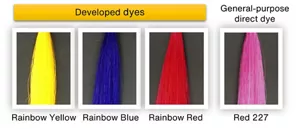Performance and New Visual Effects of Oxidizing Hair Colors Using Rainbow Dyes
Hair Color
Hair colors are familiar to people around the world in that they not only make us look beautiful, but also give us confidence and energy. Dyes contained in hair color agents are classed roughly into direct dyes, which have already been colored, and oxidizing dyes, which color hair in the process of dyeing. Generally, direct dyes are made of large molecules and offer inferior dyeability and color fastness. Oxidizing dyes, in contrast, provide a good balance between penetration and fixation since the molecular size is determined while the dye precursor and the toning agent are forming covalent bonds in the process of penetration, but some oxidizing dyes may cause irritation or other symptoms to the skin. To solve these problems, Kao has been working on the development of direct dyes that can be used in oxidizing hair color products.
There are some requirements to meet when developing direct dyes. For example, they must have a low risk of causing allergies, must be stable when used in oxidizing hair color formulations, must be alkaline and easily penetrate into the hair, and must not color the skin. Eventually, we developed vivid yellow, red, and blue dissociated azo dyes that have a phenolic hydroxyl group in common (hereinafter called Rainbow Dyes) (Figure 1).

Figure 1 Hair dyeability of oxidizing hair color formulations (pH 10, hydrogen peroxide: 3%)
Rainbow Dyes have the following features:
-
Three-dimensional, deep, high-definition coloring
By combining Kao’s technology for precisely controlling the depth of penetration of dyes into hair developed based on hair research using Fuji Film’s technology for designing and synthesizing dye molecules, which was itself developed based on R&D on photosensitive materials, we flexibly controlled the depth of dye penetration into hair to achieve deep, three-dimensional coloring. -
Toning for versatile expression of colors
Three vivid primary colors (red, blue, and yellow) can be combined for versatile expression of a wide range of colors. -
Non-reactive and long lasting
The unique design of dye molecule size and charge control means the dyes do not easily color skin but readily dye hair, and the coloring is long-lasting.
Hair dyed with hair colors containing Rainbow Dyes displays different vivid colors depending on its movement, the way light strikes it, and the viewing angle (moving effect). We market this Rainbow Dye technology globally through hair color products for hair salons.
Video: Moving effect of Rainbow Dyes
The following video does not include audio, and a text transcription of its visual content is available.
A transcript is available here.
This video shows how the colors of approx. 20-cm bundles of hair dyed with hair colors containing Rainbow Dyes change when moved. When the bundles of hair are lifted with a rod, the projections exhibit vivid and lustrous colors. On the other hand, the depressions above the projections present a dark-blue color that differs from the colors of the projections. The effect of the hair colors dynamically changing the shade and luster of the hair according to the angle from which it is viewed is called the “moving effect.”
- Home
- Innovation
- Research & Development
- Product Development Research
- Hair Care
- Performance and New Visual Effects of Oxidizing Hair Colors Using Rainbow Dyes
- Home
- Innovation
- Research & Development
- Product Development Research
- Hair Care
- Performance and New Visual Effects of Oxidizing Hair Colors Using Rainbow Dyes
